Critical Essay: Ageing Workforce Implications on Organizations
VerifiedAdded on 2022/09/13
|9
|1815
|11
Essay
AI Summary
This essay delves into the significant implications of an ageing workforce on organizational behavior. It begins by defining the ageing workforce and highlighting the challenges and opportunities associated with it. The discussion then moves to explore three key implications: contending with bias, redefining career and life goals, and adapting to maintain productivity. The essay examines how age-related stereotypes and biases can affect recruitment and employee relations, emphasizing the need for transparent and fair practices. It also discusses the need for flexible work arrangements and the importance of aligning career paths with individual goals. Finally, the essay considers the importance of adapting work roles and practices to accommodate the diverse needs and capabilities of older workers, ensuring their continued productivity and well-being. The conclusion emphasizes the need for organizations to view the ageing workforce as an opportunity and to implement strategies such as intergenerational workshops and mentoring to address the challenges and leverage the benefits of an increasingly mature workforce.

Running Head: ORGANIZATIONAL BEHAVIOUR
ORGANIZATIONAL BEHAVIOUR
Name of the Student
Name of the University
Author Note
ORGANIZATIONAL BEHAVIOUR
Name of the Student
Name of the University
Author Note
Paraphrase This Document
Need a fresh take? Get an instant paraphrase of this document with our AI Paraphraser

1ORGANIZATIONAL BEHAVIOUR
Table of Contents
Introduction................................................................................................................................2
Discussion..................................................................................................................................2
Implications of Ageing Workforce in Organization..............................................................2
Three Implications of the Ageing Workforce for Organizational Behavior..........................3
Conclusion..................................................................................................................................5
Reference....................................................................................................................................7
Table of Contents
Introduction................................................................................................................................2
Discussion..................................................................................................................................2
Implications of Ageing Workforce in Organization..............................................................2
Three Implications of the Ageing Workforce for Organizational Behavior..........................3
Conclusion..................................................................................................................................5
Reference....................................................................................................................................7
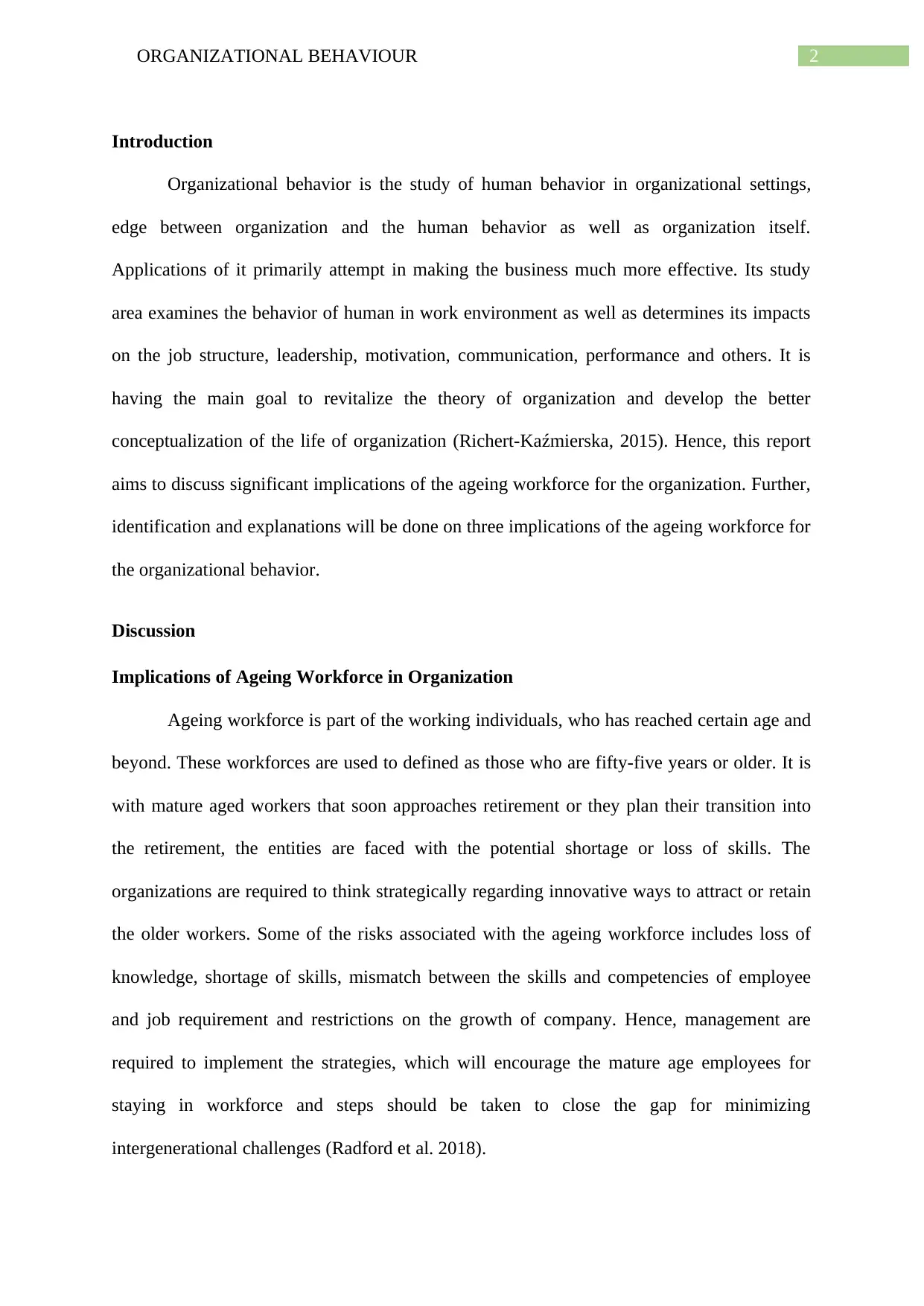
2ORGANIZATIONAL BEHAVIOUR
Introduction
Organizational behavior is the study of human behavior in organizational settings,
edge between organization and the human behavior as well as organization itself.
Applications of it primarily attempt in making the business much more effective. Its study
area examines the behavior of human in work environment as well as determines its impacts
on the job structure, leadership, motivation, communication, performance and others. It is
having the main goal to revitalize the theory of organization and develop the better
conceptualization of the life of organization (Richert-Kaźmierska, 2015). Hence, this report
aims to discuss significant implications of the ageing workforce for the organization. Further,
identification and explanations will be done on three implications of the ageing workforce for
the organizational behavior.
Discussion
Implications of Ageing Workforce in Organization
Ageing workforce is part of the working individuals, who has reached certain age and
beyond. These workforces are used to defined as those who are fifty-five years or older. It is
with mature aged workers that soon approaches retirement or they plan their transition into
the retirement, the entities are faced with the potential shortage or loss of skills. The
organizations are required to think strategically regarding innovative ways to attract or retain
the older workers. Some of the risks associated with the ageing workforce includes loss of
knowledge, shortage of skills, mismatch between the skills and competencies of employee
and job requirement and restrictions on the growth of company. Hence, management are
required to implement the strategies, which will encourage the mature age employees for
staying in workforce and steps should be taken to close the gap for minimizing
intergenerational challenges (Radford et al. 2018).
Introduction
Organizational behavior is the study of human behavior in organizational settings,
edge between organization and the human behavior as well as organization itself.
Applications of it primarily attempt in making the business much more effective. Its study
area examines the behavior of human in work environment as well as determines its impacts
on the job structure, leadership, motivation, communication, performance and others. It is
having the main goal to revitalize the theory of organization and develop the better
conceptualization of the life of organization (Richert-Kaźmierska, 2015). Hence, this report
aims to discuss significant implications of the ageing workforce for the organization. Further,
identification and explanations will be done on three implications of the ageing workforce for
the organizational behavior.
Discussion
Implications of Ageing Workforce in Organization
Ageing workforce is part of the working individuals, who has reached certain age and
beyond. These workforces are used to defined as those who are fifty-five years or older. It is
with mature aged workers that soon approaches retirement or they plan their transition into
the retirement, the entities are faced with the potential shortage or loss of skills. The
organizations are required to think strategically regarding innovative ways to attract or retain
the older workers. Some of the risks associated with the ageing workforce includes loss of
knowledge, shortage of skills, mismatch between the skills and competencies of employee
and job requirement and restrictions on the growth of company. Hence, management are
required to implement the strategies, which will encourage the mature age employees for
staying in workforce and steps should be taken to close the gap for minimizing
intergenerational challenges (Radford et al. 2018).
⊘ This is a preview!⊘
Do you want full access?
Subscribe today to unlock all pages.

Trusted by 1+ million students worldwide
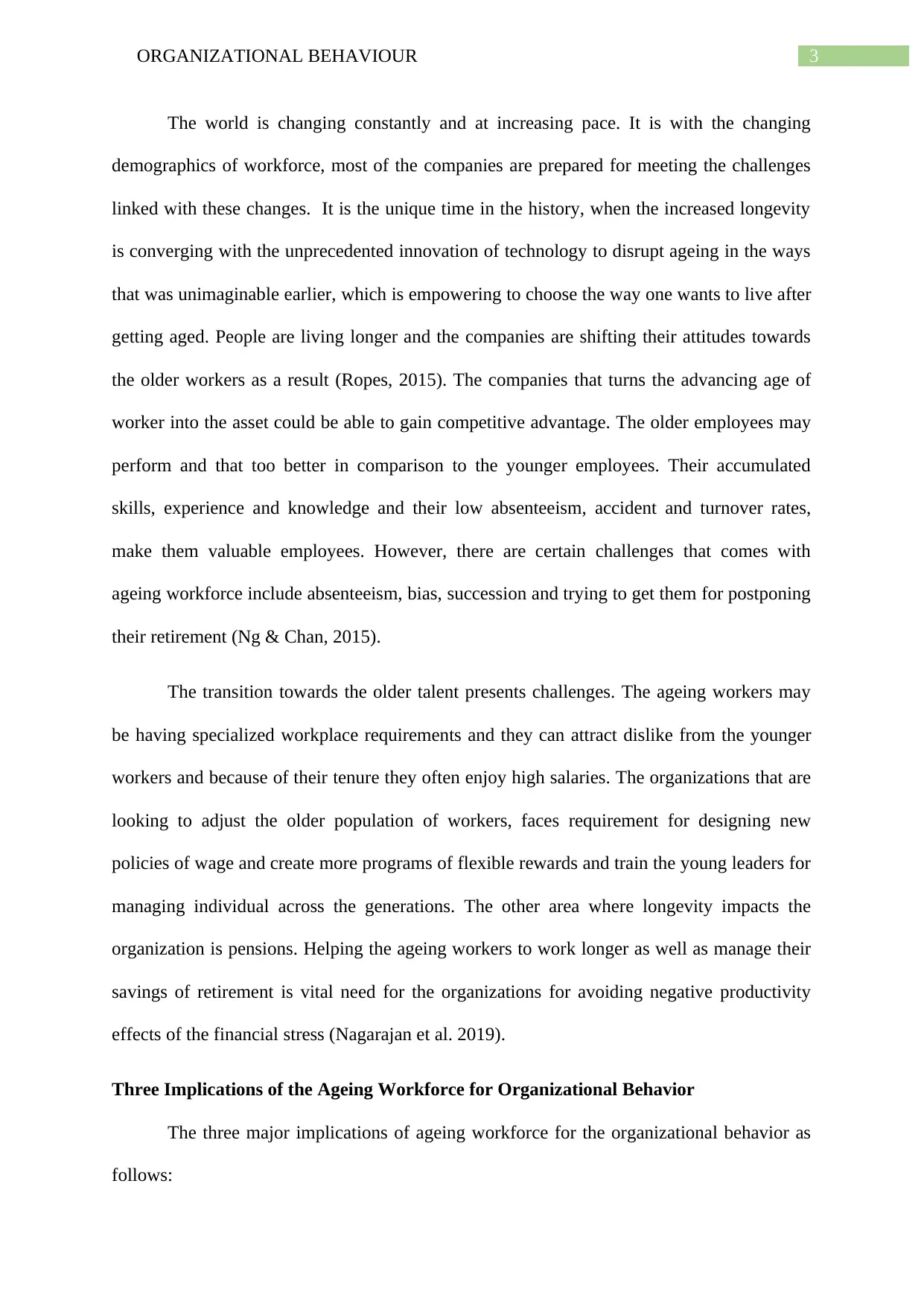
3ORGANIZATIONAL BEHAVIOUR
The world is changing constantly and at increasing pace. It is with the changing
demographics of workforce, most of the companies are prepared for meeting the challenges
linked with these changes. It is the unique time in the history, when the increased longevity
is converging with the unprecedented innovation of technology to disrupt ageing in the ways
that was unimaginable earlier, which is empowering to choose the way one wants to live after
getting aged. People are living longer and the companies are shifting their attitudes towards
the older workers as a result (Ropes, 2015). The companies that turns the advancing age of
worker into the asset could be able to gain competitive advantage. The older employees may
perform and that too better in comparison to the younger employees. Their accumulated
skills, experience and knowledge and their low absenteeism, accident and turnover rates,
make them valuable employees. However, there are certain challenges that comes with
ageing workforce include absenteeism, bias, succession and trying to get them for postponing
their retirement (Ng & Chan, 2015).
The transition towards the older talent presents challenges. The ageing workers may
be having specialized workplace requirements and they can attract dislike from the younger
workers and because of their tenure they often enjoy high salaries. The organizations that are
looking to adjust the older population of workers, faces requirement for designing new
policies of wage and create more programs of flexible rewards and train the young leaders for
managing individual across the generations. The other area where longevity impacts the
organization is pensions. Helping the ageing workers to work longer as well as manage their
savings of retirement is vital need for the organizations for avoiding negative productivity
effects of the financial stress (Nagarajan et al. 2019).
Three Implications of the Ageing Workforce for Organizational Behavior
The three major implications of ageing workforce for the organizational behavior as
follows:
The world is changing constantly and at increasing pace. It is with the changing
demographics of workforce, most of the companies are prepared for meeting the challenges
linked with these changes. It is the unique time in the history, when the increased longevity
is converging with the unprecedented innovation of technology to disrupt ageing in the ways
that was unimaginable earlier, which is empowering to choose the way one wants to live after
getting aged. People are living longer and the companies are shifting their attitudes towards
the older workers as a result (Ropes, 2015). The companies that turns the advancing age of
worker into the asset could be able to gain competitive advantage. The older employees may
perform and that too better in comparison to the younger employees. Their accumulated
skills, experience and knowledge and their low absenteeism, accident and turnover rates,
make them valuable employees. However, there are certain challenges that comes with
ageing workforce include absenteeism, bias, succession and trying to get them for postponing
their retirement (Ng & Chan, 2015).
The transition towards the older talent presents challenges. The ageing workers may
be having specialized workplace requirements and they can attract dislike from the younger
workers and because of their tenure they often enjoy high salaries. The organizations that are
looking to adjust the older population of workers, faces requirement for designing new
policies of wage and create more programs of flexible rewards and train the young leaders for
managing individual across the generations. The other area where longevity impacts the
organization is pensions. Helping the ageing workers to work longer as well as manage their
savings of retirement is vital need for the organizations for avoiding negative productivity
effects of the financial stress (Nagarajan et al. 2019).
Three Implications of the Ageing Workforce for Organizational Behavior
The three major implications of ageing workforce for the organizational behavior as
follows:
Paraphrase This Document
Need a fresh take? Get an instant paraphrase of this document with our AI Paraphraser
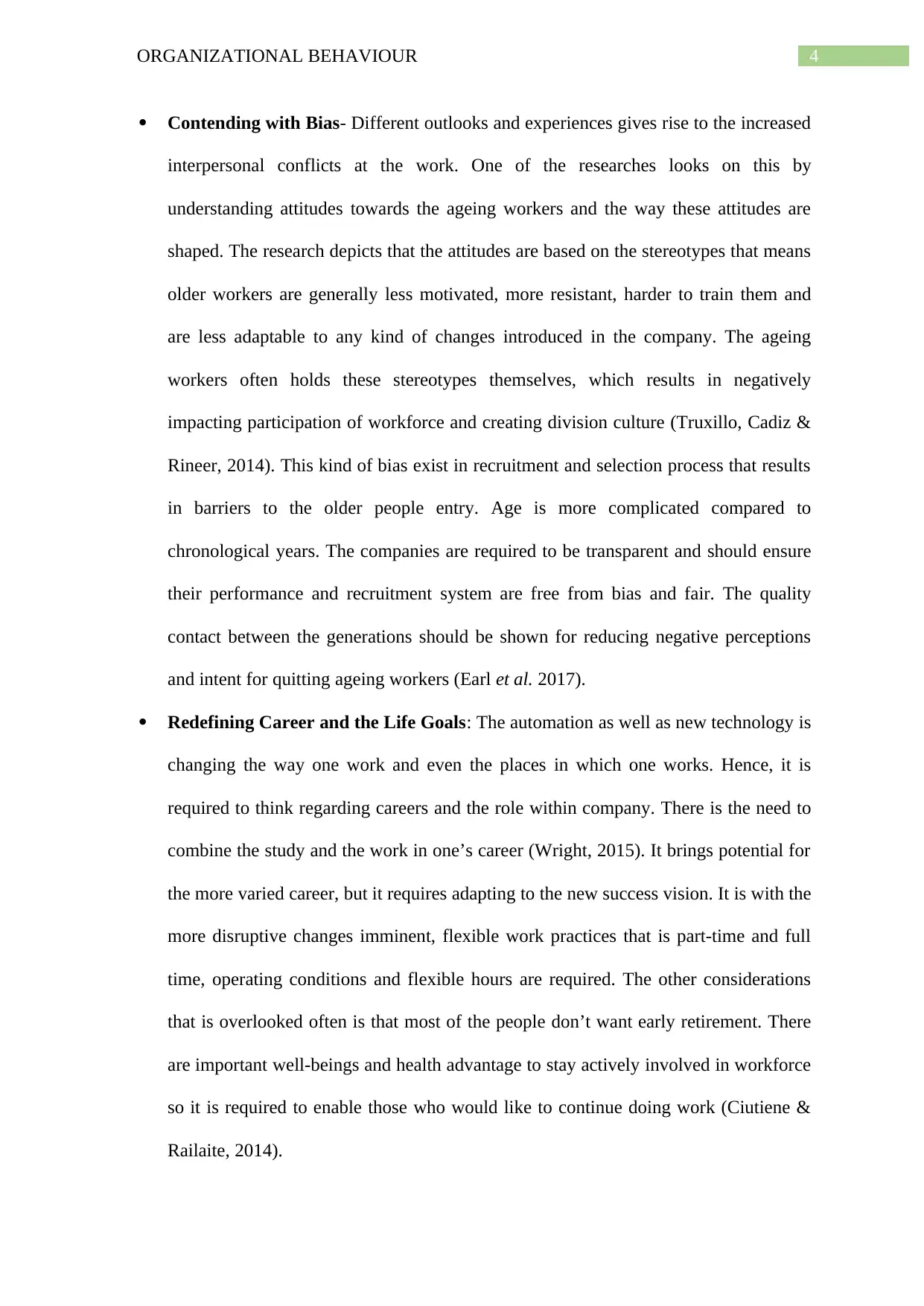
4ORGANIZATIONAL BEHAVIOUR
Contending with Bias- Different outlooks and experiences gives rise to the increased
interpersonal conflicts at the work. One of the researches looks on this by
understanding attitudes towards the ageing workers and the way these attitudes are
shaped. The research depicts that the attitudes are based on the stereotypes that means
older workers are generally less motivated, more resistant, harder to train them and
are less adaptable to any kind of changes introduced in the company. The ageing
workers often holds these stereotypes themselves, which results in negatively
impacting participation of workforce and creating division culture (Truxillo, Cadiz &
Rineer, 2014). This kind of bias exist in recruitment and selection process that results
in barriers to the older people entry. Age is more complicated compared to
chronological years. The companies are required to be transparent and should ensure
their performance and recruitment system are free from bias and fair. The quality
contact between the generations should be shown for reducing negative perceptions
and intent for quitting ageing workers (Earl et al. 2017).
Redefining Career and the Life Goals: The automation as well as new technology is
changing the way one work and even the places in which one works. Hence, it is
required to think regarding careers and the role within company. There is the need to
combine the study and the work in one’s career (Wright, 2015). It brings potential for
the more varied career, but it requires adapting to the new success vision. It is with the
more disruptive changes imminent, flexible work practices that is part-time and full
time, operating conditions and flexible hours are required. The other considerations
that is overlooked often is that most of the people don’t want early retirement. There
are important well-beings and health advantage to stay actively involved in workforce
so it is required to enable those who would like to continue doing work (Ciutiene &
Railaite, 2014).
Contending with Bias- Different outlooks and experiences gives rise to the increased
interpersonal conflicts at the work. One of the researches looks on this by
understanding attitudes towards the ageing workers and the way these attitudes are
shaped. The research depicts that the attitudes are based on the stereotypes that means
older workers are generally less motivated, more resistant, harder to train them and
are less adaptable to any kind of changes introduced in the company. The ageing
workers often holds these stereotypes themselves, which results in negatively
impacting participation of workforce and creating division culture (Truxillo, Cadiz &
Rineer, 2014). This kind of bias exist in recruitment and selection process that results
in barriers to the older people entry. Age is more complicated compared to
chronological years. The companies are required to be transparent and should ensure
their performance and recruitment system are free from bias and fair. The quality
contact between the generations should be shown for reducing negative perceptions
and intent for quitting ageing workers (Earl et al. 2017).
Redefining Career and the Life Goals: The automation as well as new technology is
changing the way one work and even the places in which one works. Hence, it is
required to think regarding careers and the role within company. There is the need to
combine the study and the work in one’s career (Wright, 2015). It brings potential for
the more varied career, but it requires adapting to the new success vision. It is with the
more disruptive changes imminent, flexible work practices that is part-time and full
time, operating conditions and flexible hours are required. The other considerations
that is overlooked often is that most of the people don’t want early retirement. There
are important well-beings and health advantage to stay actively involved in workforce
so it is required to enable those who would like to continue doing work (Ciutiene &
Railaite, 2014).
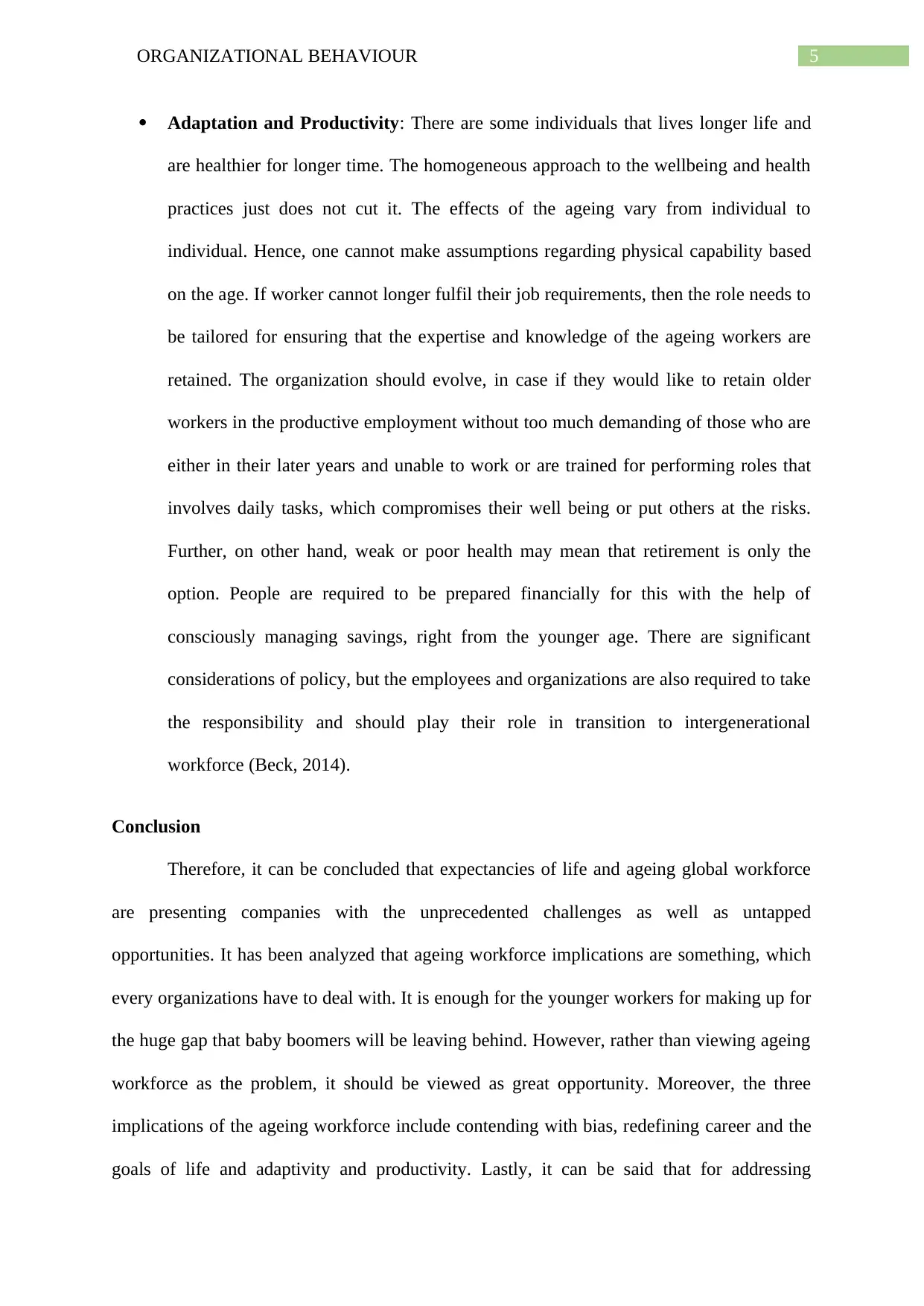
5ORGANIZATIONAL BEHAVIOUR
Adaptation and Productivity: There are some individuals that lives longer life and
are healthier for longer time. The homogeneous approach to the wellbeing and health
practices just does not cut it. The effects of the ageing vary from individual to
individual. Hence, one cannot make assumptions regarding physical capability based
on the age. If worker cannot longer fulfil their job requirements, then the role needs to
be tailored for ensuring that the expertise and knowledge of the ageing workers are
retained. The organization should evolve, in case if they would like to retain older
workers in the productive employment without too much demanding of those who are
either in their later years and unable to work or are trained for performing roles that
involves daily tasks, which compromises their well being or put others at the risks.
Further, on other hand, weak or poor health may mean that retirement is only the
option. People are required to be prepared financially for this with the help of
consciously managing savings, right from the younger age. There are significant
considerations of policy, but the employees and organizations are also required to take
the responsibility and should play their role in transition to intergenerational
workforce (Beck, 2014).
Conclusion
Therefore, it can be concluded that expectancies of life and ageing global workforce
are presenting companies with the unprecedented challenges as well as untapped
opportunities. It has been analyzed that ageing workforce implications are something, which
every organizations have to deal with. It is enough for the younger workers for making up for
the huge gap that baby boomers will be leaving behind. However, rather than viewing ageing
workforce as the problem, it should be viewed as great opportunity. Moreover, the three
implications of the ageing workforce include contending with bias, redefining career and the
goals of life and adaptivity and productivity. Lastly, it can be said that for addressing
Adaptation and Productivity: There are some individuals that lives longer life and
are healthier for longer time. The homogeneous approach to the wellbeing and health
practices just does not cut it. The effects of the ageing vary from individual to
individual. Hence, one cannot make assumptions regarding physical capability based
on the age. If worker cannot longer fulfil their job requirements, then the role needs to
be tailored for ensuring that the expertise and knowledge of the ageing workers are
retained. The organization should evolve, in case if they would like to retain older
workers in the productive employment without too much demanding of those who are
either in their later years and unable to work or are trained for performing roles that
involves daily tasks, which compromises their well being or put others at the risks.
Further, on other hand, weak or poor health may mean that retirement is only the
option. People are required to be prepared financially for this with the help of
consciously managing savings, right from the younger age. There are significant
considerations of policy, but the employees and organizations are also required to take
the responsibility and should play their role in transition to intergenerational
workforce (Beck, 2014).
Conclusion
Therefore, it can be concluded that expectancies of life and ageing global workforce
are presenting companies with the unprecedented challenges as well as untapped
opportunities. It has been analyzed that ageing workforce implications are something, which
every organizations have to deal with. It is enough for the younger workers for making up for
the huge gap that baby boomers will be leaving behind. However, rather than viewing ageing
workforce as the problem, it should be viewed as great opportunity. Moreover, the three
implications of the ageing workforce include contending with bias, redefining career and the
goals of life and adaptivity and productivity. Lastly, it can be said that for addressing
⊘ This is a preview!⊘
Do you want full access?
Subscribe today to unlock all pages.

Trusted by 1+ million students worldwide
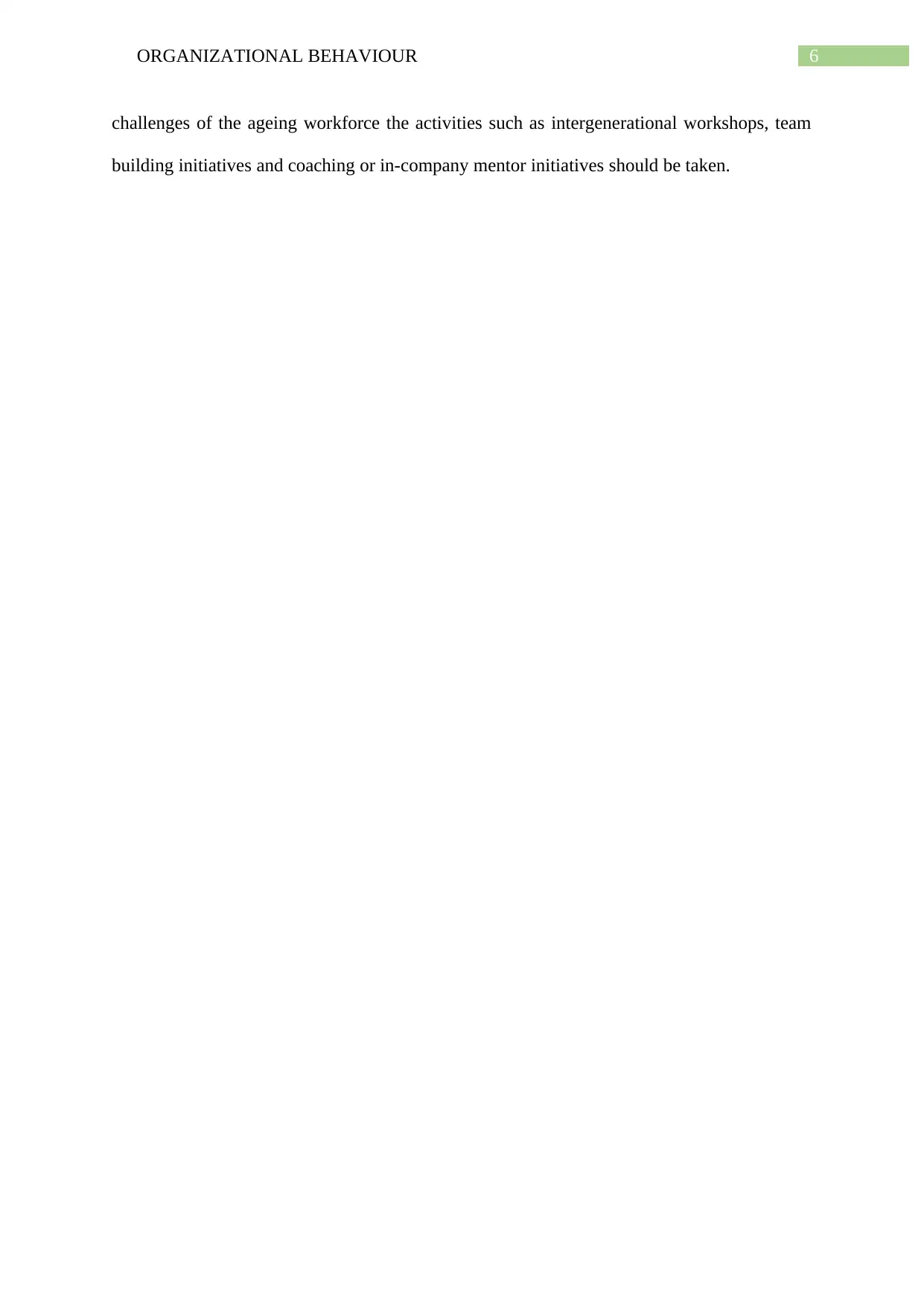
6ORGANIZATIONAL BEHAVIOUR
challenges of the ageing workforce the activities such as intergenerational workshops, team
building initiatives and coaching or in-company mentor initiatives should be taken.
challenges of the ageing workforce the activities such as intergenerational workshops, team
building initiatives and coaching or in-company mentor initiatives should be taken.
Paraphrase This Document
Need a fresh take? Get an instant paraphrase of this document with our AI Paraphraser
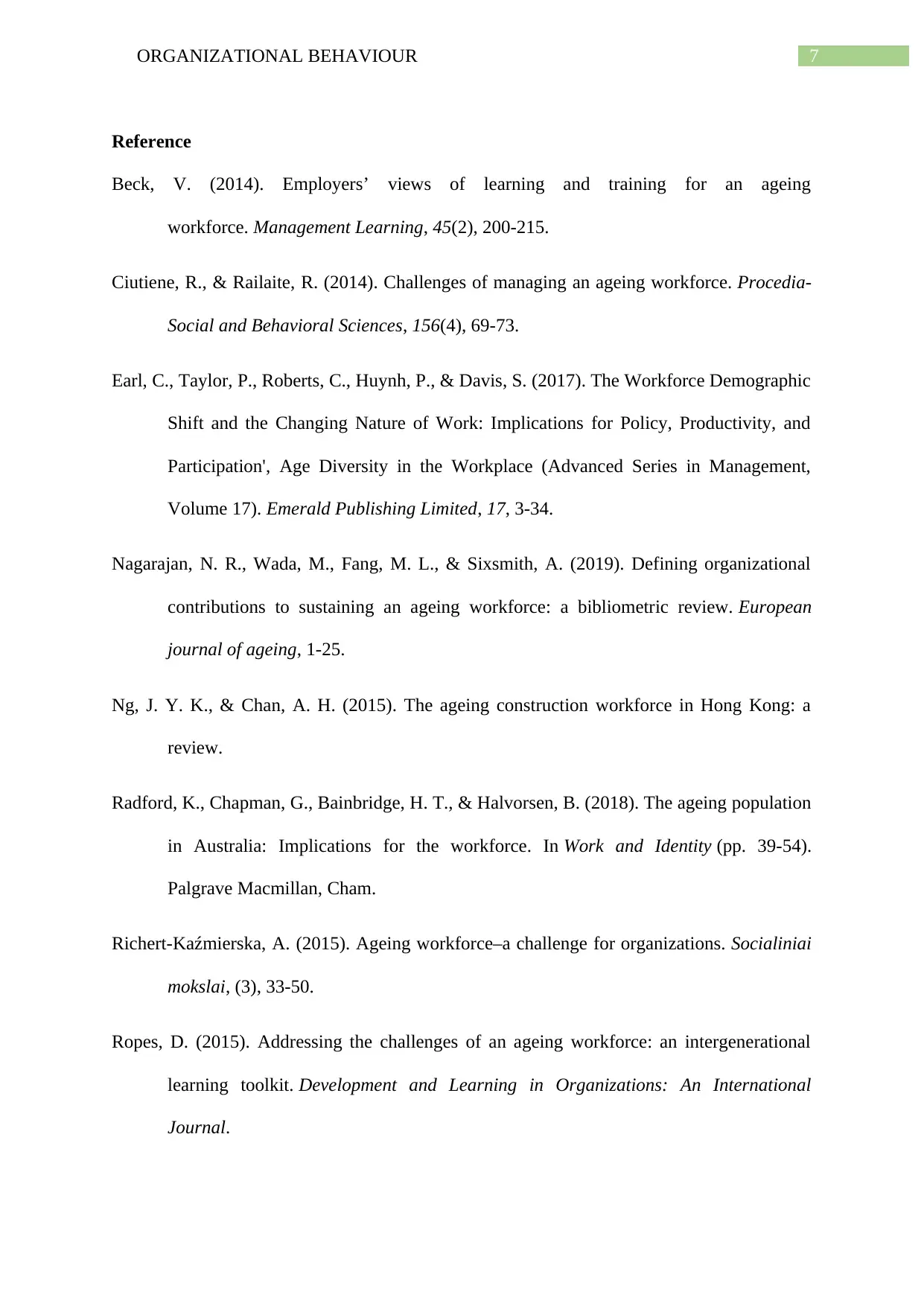
7ORGANIZATIONAL BEHAVIOUR
Reference
Beck, V. (2014). Employers’ views of learning and training for an ageing
workforce. Management Learning, 45(2), 200-215.
Ciutiene, R., & Railaite, R. (2014). Challenges of managing an ageing workforce. Procedia-
Social and Behavioral Sciences, 156(4), 69-73.
Earl, C., Taylor, P., Roberts, C., Huynh, P., & Davis, S. (2017). The Workforce Demographic
Shift and the Changing Nature of Work: Implications for Policy, Productivity, and
Participation', Age Diversity in the Workplace (Advanced Series in Management,
Volume 17). Emerald Publishing Limited, 17, 3-34.
Nagarajan, N. R., Wada, M., Fang, M. L., & Sixsmith, A. (2019). Defining organizational
contributions to sustaining an ageing workforce: a bibliometric review. European
journal of ageing, 1-25.
Ng, J. Y. K., & Chan, A. H. (2015). The ageing construction workforce in Hong Kong: a
review.
Radford, K., Chapman, G., Bainbridge, H. T., & Halvorsen, B. (2018). The ageing population
in Australia: Implications for the workforce. In Work and Identity (pp. 39-54).
Palgrave Macmillan, Cham.
Richert-Kaźmierska, A. (2015). Ageing workforce–a challenge for organizations. Socialiniai
mokslai, (3), 33-50.
Ropes, D. (2015). Addressing the challenges of an ageing workforce: an intergenerational
learning toolkit. Development and Learning in Organizations: An International
Journal.
Reference
Beck, V. (2014). Employers’ views of learning and training for an ageing
workforce. Management Learning, 45(2), 200-215.
Ciutiene, R., & Railaite, R. (2014). Challenges of managing an ageing workforce. Procedia-
Social and Behavioral Sciences, 156(4), 69-73.
Earl, C., Taylor, P., Roberts, C., Huynh, P., & Davis, S. (2017). The Workforce Demographic
Shift and the Changing Nature of Work: Implications for Policy, Productivity, and
Participation', Age Diversity in the Workplace (Advanced Series in Management,
Volume 17). Emerald Publishing Limited, 17, 3-34.
Nagarajan, N. R., Wada, M., Fang, M. L., & Sixsmith, A. (2019). Defining organizational
contributions to sustaining an ageing workforce: a bibliometric review. European
journal of ageing, 1-25.
Ng, J. Y. K., & Chan, A. H. (2015). The ageing construction workforce in Hong Kong: a
review.
Radford, K., Chapman, G., Bainbridge, H. T., & Halvorsen, B. (2018). The ageing population
in Australia: Implications for the workforce. In Work and Identity (pp. 39-54).
Palgrave Macmillan, Cham.
Richert-Kaźmierska, A. (2015). Ageing workforce–a challenge for organizations. Socialiniai
mokslai, (3), 33-50.
Ropes, D. (2015). Addressing the challenges of an ageing workforce: an intergenerational
learning toolkit. Development and Learning in Organizations: An International
Journal.
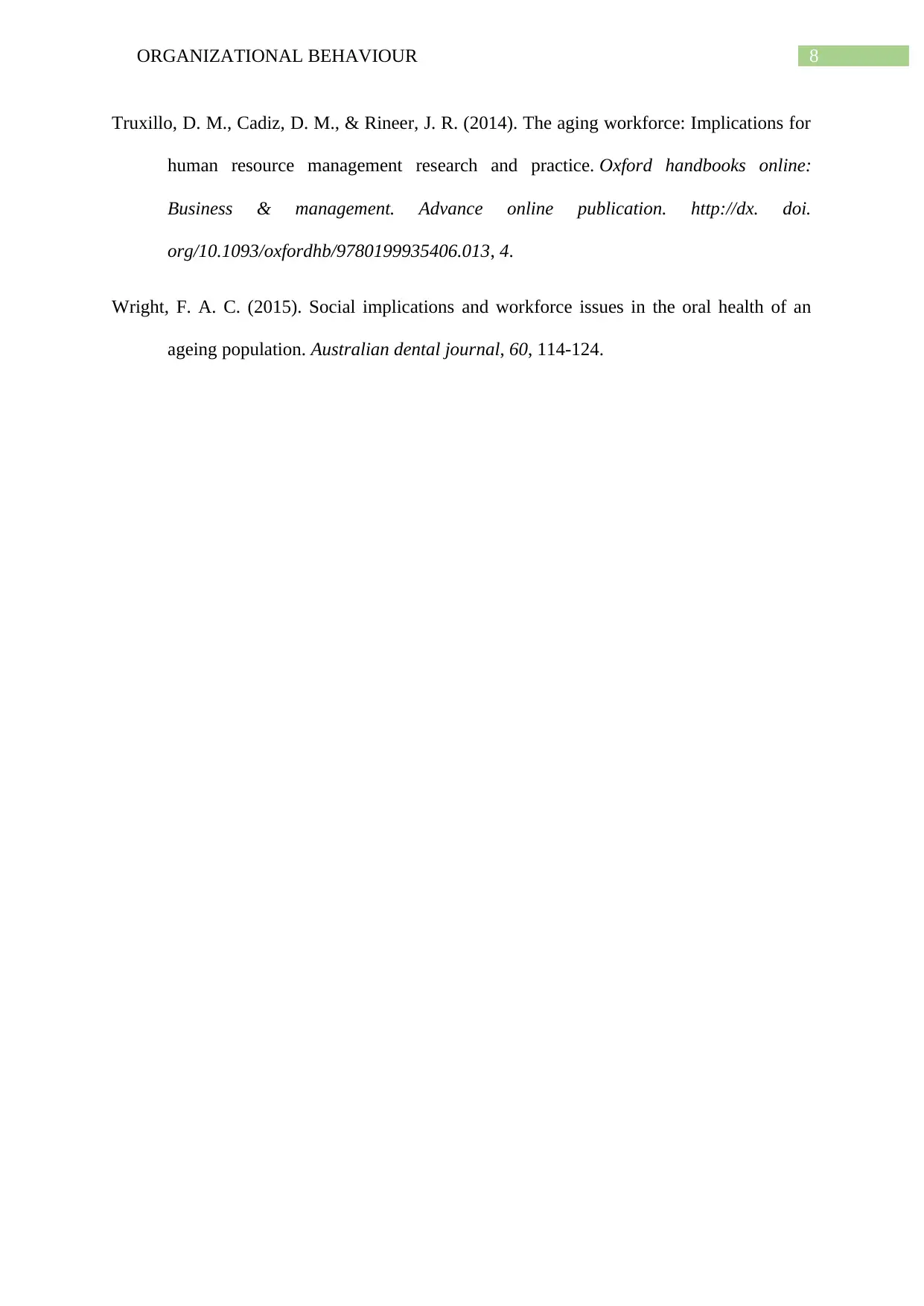
8ORGANIZATIONAL BEHAVIOUR
Truxillo, D. M., Cadiz, D. M., & Rineer, J. R. (2014). The aging workforce: Implications for
human resource management research and practice. Oxford handbooks online:
Business & management. Advance online publication. http://dx. doi.
org/10.1093/oxfordhb/9780199935406.013, 4.
Wright, F. A. C. (2015). Social implications and workforce issues in the oral health of an
ageing population. Australian dental journal, 60, 114-124.
Truxillo, D. M., Cadiz, D. M., & Rineer, J. R. (2014). The aging workforce: Implications for
human resource management research and practice. Oxford handbooks online:
Business & management. Advance online publication. http://dx. doi.
org/10.1093/oxfordhb/9780199935406.013, 4.
Wright, F. A. C. (2015). Social implications and workforce issues in the oral health of an
ageing population. Australian dental journal, 60, 114-124.
⊘ This is a preview!⊘
Do you want full access?
Subscribe today to unlock all pages.

Trusted by 1+ million students worldwide
1 out of 9
Related Documents
Your All-in-One AI-Powered Toolkit for Academic Success.
+13062052269
info@desklib.com
Available 24*7 on WhatsApp / Email
![[object Object]](/_next/static/media/star-bottom.7253800d.svg)
Unlock your academic potential
Copyright © 2020–2025 A2Z Services. All Rights Reserved. Developed and managed by ZUCOL.





